
|
||
|
Portland art blog + news + exhibition reviews + galleries + contemporary northwest art
|
||
What's next for Mickalene Thomas 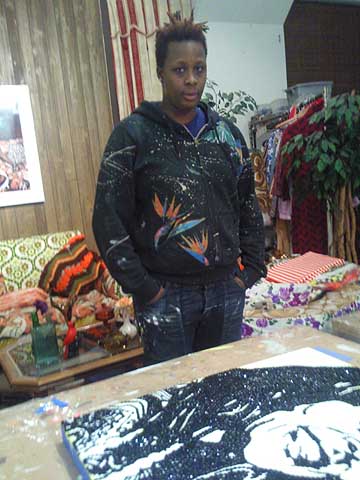 Mickalene Thomas is currently the toast of New York for her rowdy painted and rhinestone riots of patterns and personality, finishing up a successful solo show at Lehman Maupin. The work has consistently struck me as some of the boldest being done today. She's also a former Portland-based model who left to study art at Pratt then Yale (she discovered her interest in art at PSU). She still visits Portland frequently and we have a lot of mutual friends... but for a change PORT caught up with her in her Brooklyn studio to talk about her first New York solo show, her work and what is next. Jeff: Forgive me but I have to ask, why rhinestones? Mickalene: At the beginning I didn't know why. One, I always worked in different materials like sequins and glitter, all of these untraditional craft materials that I seemed to gravitate towards for my process. Once I started using rhinestones I started thinking about how they are used in the world. For me there are different qualities in the rhinestones; there are some that are acrylic, some that are glass and then some that are crystal. Each has a different quality that resembles the various elements of our culture in the way they are made and used… for instance accoutrements on garments and the way they are there to beautify or enhance a quality. 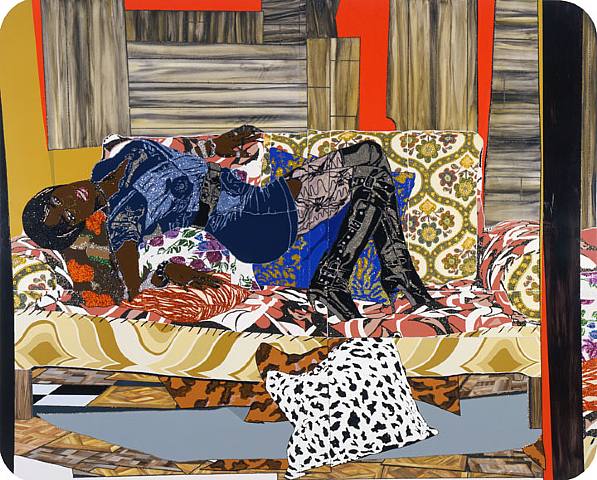 Naughty Girls (need love too) 2009 courtesy Lehman Maupin To me that dressing up is a way of masking, much in the same way a young girl dressing up in her mothers clothing so she can feel good about herself is... because she sees her mother getting dressed up in the evening and she want to emulate that kind of action. Instead of just an accoutrement that you put on, the rhinestones are actually enhancing a quality that already exists. J: So it is continuing the sitter's transformation process that began when you have your sitters dress up in the staged studio environments. After the session is done you continue to push and embolden the composition with rhinestones. It's the opposite from Warhol who was very reductive, instead you are additive. Also, unlike a flat surface.. rhinestones change as you view them from different angles, so… not to make a bad pun but in a way you are making your subjects even more boldly faceted by using them. 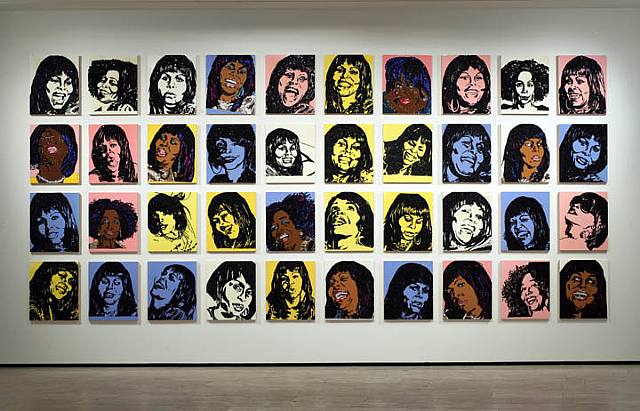 A-E-I-O-U and Sometimes Y (2009) courtesy Lehman Maupin MT: I'm definitely thinking about Warhol's reductive elements but I'm embellishing them my way which makes them quite different. I think about how Warhol used these graphic icons that were already out in the world and presented them so boldly. That "here it is" stance is something I think about and I would say appropriate from. These portraits stem from his work in a way, especially how this new multi-portrait piece (A-E-I-O-U and Sometimes Y) is presented. I did a piece called "Sweet and Out Front" where I took all these characters from "Sweet Sweetback's Badasssss Song" the Melvin Van Peeples movie. I was invited to be in this group show Sweet Back related to the movie and so many people were so fixated on Melvin Van Peeples and the main characters in the movie. And I thought, What about the women in the movie?... because most of his interaction is with all of these different women and no one really talks about them in the movie. So what I did was take clips of all of these women in the movie and composed them in the same way as Warhol's Jackie O. I thought it was really successful because it brought these women to the front. That's why I called it Sweet and Out Front because these women had been used as background or a window or entry where the Melvin Van Peoples character was going into next. That Movie is kind of trippy. The first time I saw it I was like Wow, I didn't know this movie existed? That first scene his son Mario Van Peoples is having sex with this older woman and he is actually having sex for the first time, he like actually lost his virginity on film, it is so wild, ha! (see IFC #21) J: Sounds like a Hollywood industry right of passage. Then I see the Chris Ofili image above you there, obviously your work shares some similar concerns. MT: I like Chris Ofili a lot J: But he is different, he's more iconographic less interested in portraiture… like he's creating a very altered version of those Russian icons… he's a master of pattern and flash but his collage elements from porn and elephant dung are also very loaded… it certainly got Giuliani all bent out of sorts. MT: Yeah he's living in Trinidad now with Peter Doig, they are good friends. Chris Ofili's was probably one of the first works I saw when I was in undergrad at Pratt. They had the Sensation show at the Brooklyn Museum. Giuliani, the Mayor of New York did not like it at all. Well the Brooklyn Museum had started a program called the Ask Me program and they would put students next to paintings and if they had questions about it they could ask you. So I volunteered and for the duration of the show my post was standing next to the Chris Ofili. J: So you were stationed next to the single most controversial bit of art shown in New York for the past decade or more… nice, what was that like? MT: I was just bombarded by dozens of questions at once with people getting angry at me at points as if I had made the work. I was thinking "This is really exciting" I was like a sophomore in college and it was exciting to see a work of art cause such strong feelings. Some people loved it but all that anger seemed to be sparked by a frustration and misread the work as something that it was not. 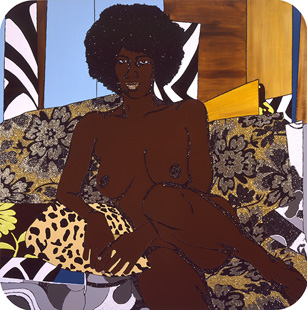 Ofili's work had a quality that was an influence at that time as a student when I was inspired by everything. It made me feel like you could make anything. I remember thinking Mickey, you can do anything you want and it wasn't based on whether I liked or didn't like his work… it simply opened up the possibilities. I could make what I wanted to make. J: I still regret not getting a small print of his that Pulliam Deffenbaugh had for a mere $400 about 10 years ago. I went back later that day and it was gone. He has such a sure hand, great lines and an impossible talent for pattern MT: His last show at David Zwirner was pretty amazing. I particularly liked the sculptures a lot. 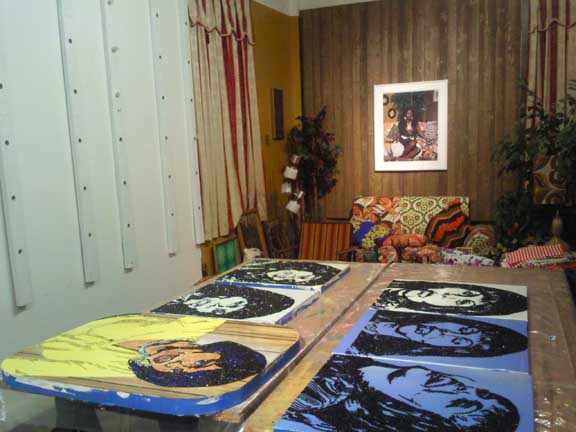 studio view J: I can see it here but describe what is your own studio is like now that the show is almost upon you? MT: A lot of the work just left the other day so right now I'm looking at these bare walls. It's strange when so much of the work is gone, but I guess that's the fun part… going back to zero and at that moment you start again. J: And you are currently in between the opening of your solo show at Lehman Maupin and a group show you just curated? MT: Exactly, this is probably one of the hardest shows I've ever had to prepare for because I just had a solo show November in Chicago and when I agreed to do this solo show everything seemed so far away and then it kind of just crept up. So I feel like I haven't rested for quite a while, but it feels good. J: How has that been? The world has changed so much… even since last November everybody's mindset seems to have changed around the economy and various new political realities? MT: I'm working…. working in the studio. I mean, you just allow whatever is happening to take its course, the only thing I can control is what is happening here… in the studio. So far I mean it's been pretty good, the economy hasn't effected my sales. Yes, things are slow overall but people are still interested in buying art. They are being a little more conscientious about the kind of art they are buying… they aren't buying because it is a hot commodity or because they have someone telling them to buy it. They are collecting because they have an interest in what the artist is doing. It is a different than it was and it's a positive development right now. J: The stuff I see selling right now seems to be work that makes its own argument… it is stuff that is noticeably extra good and stands out from its peers. This is even happening in Portland, only the best stuff sells… even when its way more expensive than the other work in the room. If you are a real collector it isn't an investment consideration, you are more invested in the work on a personal level. MT: Yeah, I was talking to one of my collectors recently and I was really happy that they had the work because you could tell they were buying works of art that they really liked and responded to and not because they had been marketed to. That is really important to me. I've been fortunate that my work hasn't really hit some auction market where it has been flipped over but of course that's not to say that wont happen but most of the collectors who have my work I do have a connection with. It's really funny because we were just updating my card catalog of images and it's a testament to the galleries that I work with but it's nice to see so much of the work going to "collectors" in the true sense of the word. J: and now onto the work itself, I've seen it in several galleries but this is the first time I've seen it in your studio setting, and I'm struck by how very theatrical the work and workspace is. MT: Drama is good 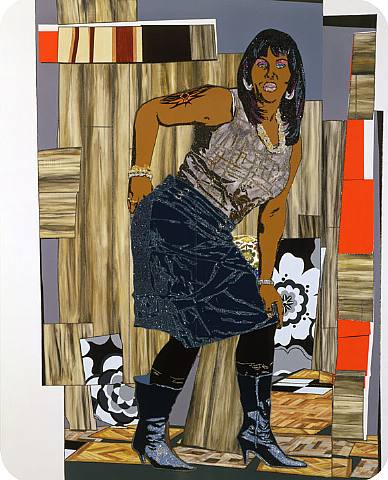
All she wants to do is dance (Fran) 2009 courtesy Lehman Maupin J: You have sets here. MT: That is where the work begins. It starts with a particular idea which I employ the sets as a way of composing. In the past it was just a simple photo studio where you put up a piece of cloth and you put the model in front of it and you just shoot them. Well it developed and grew out of that moment and became a larger entity in itself where it was like, oh I can have a mat sitting next to her and then have her sitting in a chair and the next thing I know I'm creating entire environments for the models and now that is become a work of art in itself. I've actually had several opportunities where I've been asked to do site specific installations. Not many know me for my installations but it is nice when I'm able to do it, because that's where all of the work begins before the paintings and then the photographs, then the collages and then the paintings. 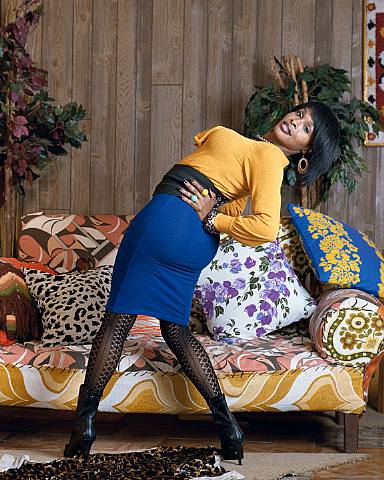 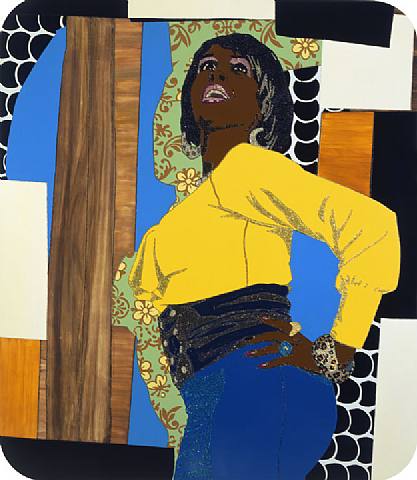 Dont Forget About Me (Keri) 2009 courtesy Lehman Maupin J: And you've got just reams and reams of patterned fabric over there in the corner. I've always appreciated work by people like Philip Taaffe and Anna Albers, its all about pattern. Then you have work like Warhol's camouflage series. Also, you always seem to use strong contrasting patterns, you are the complete opposite of Agnes Martin; you are putting green, goldenrod and red and turquoise together. Yet there is something about pattern from you or Ages Martin or Frank Stella that always seems like a social statement…. Something about the way you want to approach the world and be read by it. MT: I've always liked strong contrasts, it kind of embodies the force of contradiction. It's a way to acknowledge things that are going on in our world. For me these installations with all of these different patterns relates to the kind of overload of information that we are constantly bombarded with. I try to infuse the models with a sense of empowerment, because they are sitting in this resting place within the composition. The models become the focus point because there is all of this stuff around them and they are a strong contrast. Yet all of the patterns can also be the focus point, demanding a lot of attention and I want that kind of tension between intense pattern activity and the more in model. It speaks to things that I'm attracted to and the way I grew up. It's really just my aesthetic taste, particularly photographs of Africa from the 1970's which influenced this direction. 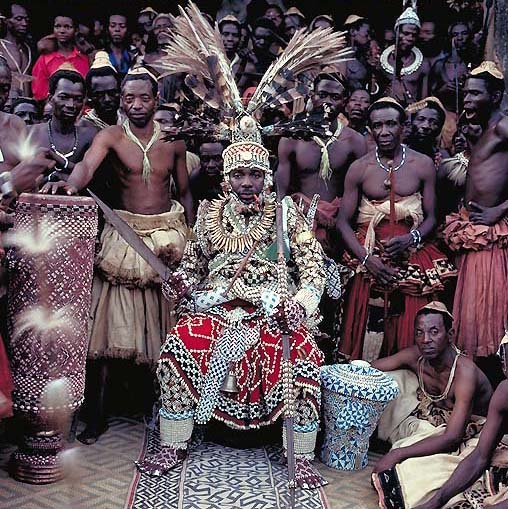 Photo of an African king by Daniel Laine J: And in terms of this show is it more focused on single portraits? I've seen the previous images of you wrestling yourself but right now I'm just seeing these smaller works where the figure commands almost the entire picture plane. MT: Yeah this show is more about portraiture. What you see here in these small portraits is actually 17 pieces of a larger piece which is 40 panels; the other 23 are gone already. I do a lot of portraits and I sort of re crop the images for the paintings. Eventually I had this surplus of images I hadn't used and I sort of reconfigured them into one aggregate piece where I avoid the background patterns and just focus on the figures. J: It really does seem to be related to Warhol but with a difference, are these all specific people close to you rather than celebrities? MT: Yeah these are all specific people in my life, that's my mother up there on the bottom left with the pink and blue on top of it. And these two aren't finished yet but that is Fran, she's actually my hairdresser and the other person up there is a friend that I met through Fran. A lot of times the models that I use I have some relationship with, whether I meet them through friends or family members. Only recently have I started advertising for models like on craigslist which has been kind of interesting because it becomes this really nice process of elimination. There is the audition which is really fun and it's always interest just to see who responds. J: And you form a relationship with these models? MT: The relationship develops over a period of time and a series of conversations. If there is a connection I choose the model and the relationship develops further because I use them more than once. Sometimes it just doesn't work out because there isn't that connection. In a way it becomes kind of a collaboration and what the viewer experiences isn't because of me but because it comes from the models. J: It's your sitter's inherent qualities and personality. MT: Exactly, I have no control over that. I can put them in certain positions and ask them to pose in a certain way but how the express themselves is their inner being. J: So it isn't just the rhinestones that sparkle, it's the personality. MT: Absolutely, the rhinestones are just another element. Like that photography you see over there, all I did was take the photograph, it was fantastic and I didn't have to do anything else with it to make it vibrant. J: As a subject she has such poise and with that big thing hanging off of her neck. 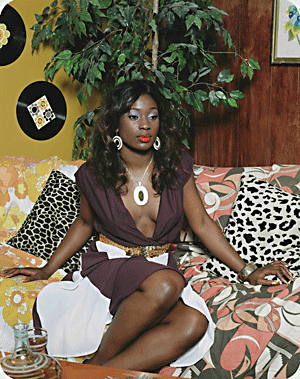 Portrait of Qusquzar (2008) MT: It is like they themselves transform as they come into the studio space. The installation is really nothing right now but when the model comes in it is really done up and everything isn't all pushed to the side like it is now. We are actually going to change it on Friday which is really exciting because I've had this one for a while. And Qusquzar she doesn't dress like she is in that photo every day, with that wig she has on… but they themselves transform becoming some other person within themselves that they probably wouldn't immediately recognize. which to me is the most exciting part. Because something else is unleashed that makes them excited and that is where the collaboration comes in. It is new for them because I often pick the shyest of the bunch because the often have the most to bring to the table because they didn't necessarily live or dress that way on a daily basis. So when they are transformed into this other person it really comes out. J: That is what separates your work from Warhol in important ways. Warhol was fascinated with famous people who were victimized or marginalized by their status in some way but you pick people that you have an intense, non fan, very real relationship with… so you can then watch them bloom. That's really interesting and powerful and kind of why I've always been drawn to your work. MT: It's fun to see and once again going back to that particular model again, I gave her a small photo of themselves from the session. So instead of pay, I'm giving them my art in appreciation. It isn't that kind of for hire transaction. In that case she was so excited because she had never had a photo of herself in the house and she blew it up. I thought that was so amazing that she looks at it every day and it makes her feel good. That was awesome. J: Having an image like that is like some nobleperson who gets a court portrait of themselves and its hangs it in their formal dining room, so all of their guests are reminded just who they are dining with. Its pompous and anachronistic today but for someone who hasn't experienced much of that kind of assertive self I'mage … its powerful. MT: A lot of these women just don't have images of themselves and when they suddenly see themselves in this light it builds a newfound confidence. But that is what my work is about it is celebrating instead of victimizing these women in a personal way. 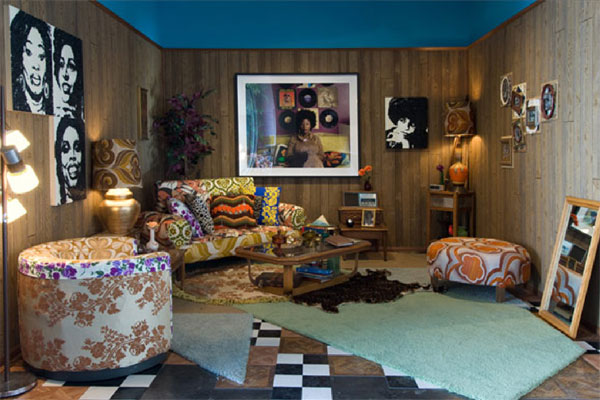 What's Love Got to Do With It (Installation 2008) J: So what is next for you? MT: On Friday we are setting up a new, expanded installation in the studio because I have an opportunity to do one in an 800 square foot space within a 5,000 square foot space in Spain that will be filled with my work, the photos, the collages, sculptures and the paintings plus the new installation. The installation will be like someone's apartment, like a really crazy apartment and since my installations aren't that well known I'm really excited about it. So that is September, then I have solo show with my LA gallery in January. J: I saw you last solo show down there, it had even more attitude than your regular solo shows (which have a ton of attitude already. 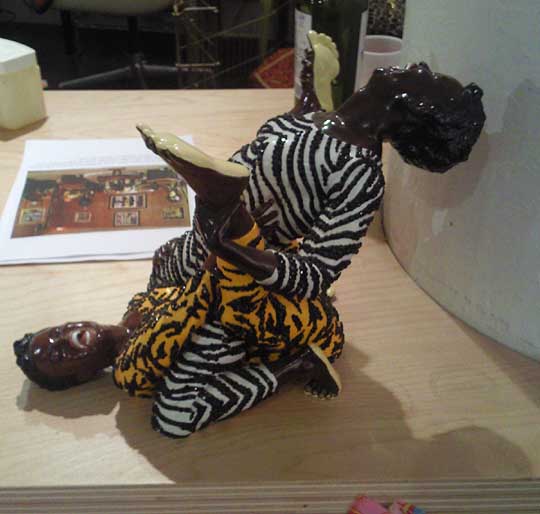
Brawlin Spitfire sculpture on Mickalene Thomas's desk MT: You mean the Brawlin Spitfire series, well they are a bit more personal because they are all me so the show has to be autobiographical. They stem from my notions of the Amazon woman and how I perceive and have cultivated for myself in the world. So that is the difference. I actually use myself a lot in the other works but I remove myself. So the brawling spitfire is me adding personal angst or ideas I have about who I am or my work. So I'm wresting myself in all of those paintings and its about instant gratification and you know the inner outer being. They are more metaphysical I guess. But I like them a lot and in many ways they might be more successful because they are more paired down and much more about the figures, rather than the other works which are figures in a patterned space. Posted by Jeff Jahn on May 02, 2009 at 9:54 | Comments (0) Comments Post a comment Thanks for signing in, . Now you can comment. (sign out)
(If you haven't left a comment here before, you may need to be approved by
the site owner before your comment will appear. Until then, it won't appear
on the entry. Thanks for waiting.)
|
| s p o n s o r s |
 |
 |
 |
 |
 |
 |
 |
 |
 |
 |
 |
 |
 |
 |

|
Site Design: Jennifer Armbrust | • | Site Development: Philippe Blanc & Katherine Bovee | |

